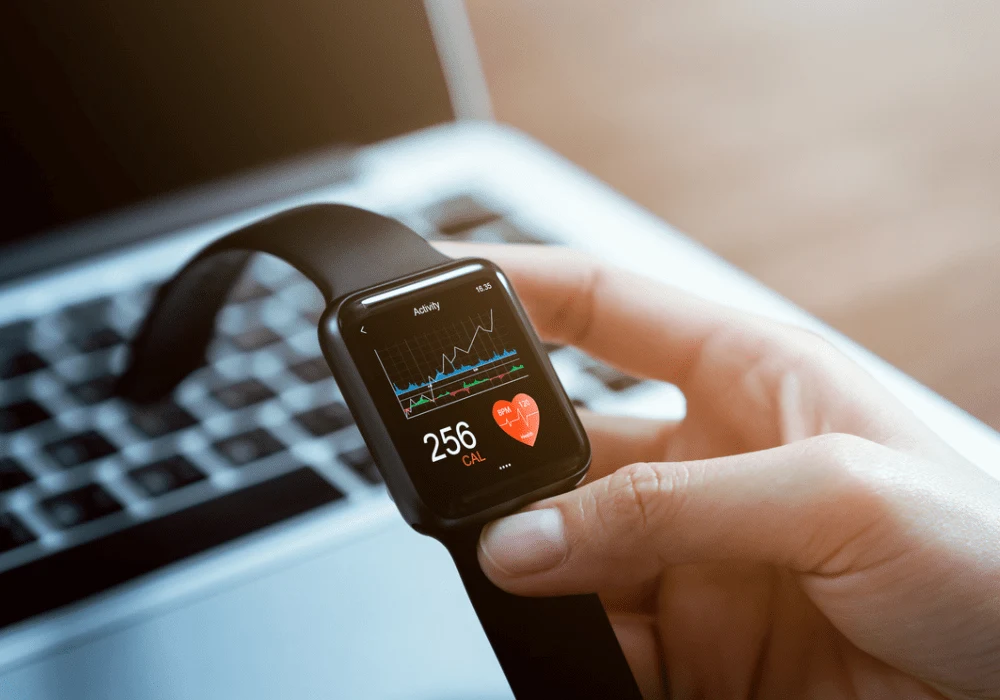The prevalence of various diseases is rising globally due to environmental changes and unhealthy lifestyles. Technological advancements and healthcare digitalisation, especially wearable technologies, offer potential solutions by providing continuous patient monitoring, improving diagnoses, and optimising therapies tailored to individual needs. Wearable devices, worn on the skin, can continuously collect, analyse, and transmit data related to vital signs and environmental information. They support applications like ecological momentary assessment (EMA) and ecological momentary intervention (EMI) to assess behaviours in real time and offer timely, personalised health strategies.
In Germany, about 28% of the population used wearables for physical activity monitoring in 2016. Wearable devices include smartwatches, fitness trackers, rings, and specialised devices that collect data through the skin. Advanced wearables can monitor various health metrics, including alcohol consumption, through non-invasive means, thus providing valuable health insights and promoting healthier lifestyles. These devices encompass functional subtypes like microneedle patches, electronic trans-epidermal tattoos for cortisol measurement, and e-textiles with integrated sensors.
Wearables can enhance healthcare by supporting diagnostic and treatment decisions through continuous data monitoring. They also engage patients in their health monitoring, potentially saving time and costs. However, there is limited research on the acceptance of wearables for health monitoring and data sharing in daily life. A study recently published in the Health Informatics Journal aims to explore the acceptance and usage behaviour of wearables in Germany, identify factors influencing their use, and examine related risks and barriers, along with the demographic characteristics of users and non-users.
Study Questionnaire
A self-designed questionnaire was used, incorporating elements from previous acceptance studies on digital tools and wearables, translated into German. The questionnaire was based on the Technology Acceptance Model (TAM) and the Unified Theory of Technology Acceptance and Use (UTAUT), focusing on perceived usefulness, ease of use, performance expectancy, effort expectancy, social influence, and facilitating conditions. Validated instruments from Yang et al. were used for acceptance questions. The questionnaire, reviewed by experts in dermatology, public health, and statistics, was pilot-tested with five participants for feedback and minor revisions. It contained 42 questions divided into four sections:
- Sociodemographic data and current usage of wearables
- Usage behaviour of wearables among current users
- Willingness to share data from wearables and with whom
- Willingness to wear wearables for future health monitoring (e.g., implants).
Survey Administration and Participant Demographics
The study included 550 participants aged between 18 and 81 years, with a mean age of 36.6 years. Regarding survey administration, 42.7% of participants (235) completed the survey via paper, while 57.3% (315) completed it online, resulting in a 78% online response rate. Wearable usage was reported by 33.8% of the participants, with higher usage among females (39.2%) compared to males (30.0%), which was statistically significant (p = .025). No significant differences were found across age groups, with usage ranging from 33.9% to 38.2% among participants aged 18 to 55 and decreasing to 26.7% in those 56 and older (p = .661). Wearable use was higher in medium and large towns (38.5%) than in small towns and rural areas (30.1%) (p = .037). Higher usage was associated with more than 4 hours of weekly physical activity (46.1%, p < .001) and higher education levels (38.7% for high school graduates and 37.3% for those with university/doctoral degrees, compared to 27.4% for those with less than a high school degree, p = .045).
Usage Patterns and Reasons for Non-Use
50.5% of non-users cited the perception of no tangible benefit as the most prevalent reason for not using wearables. 16.2% expressed concerns about cost, and 9.9% expressed concerns about data protection and privacy. About 19.8% cited various other reasons, such as a lack of knowledge or interest in wearables.
Among the 186 wearable users, 122 owned a smartwatch, 60 owned a fitness wristband, 8 owned a smart ring, and another 8 owned other wearables like chest straps for sports or smart patches for insulin measurement. About 90% of users stated that they used their wearable more than once a week, with 64.5% using it daily. The most common measurements recorded were the number of steps walked (89.7%), pulse (89.2%), distance jogged (75.1%), calories consumed (64.3%), and sleep activity (44.3%).
Concerns About Wearables and Influencing Factors
The study found that 61.5% of respondents would share their wearable health or physical activity data with their doctor or a researcher, and 42.7% would share anonymous data with wearable manufacturers. Among all respondents, 57.8% of men and 63.3% of women were willing to wear a health monitoring sensor on the skin. Participants were more willing to wear a sensor patch (46.3% men, 49.5% women) than a garment with sensors (46.1% men, 29.5% women) or a health monitoring implant (20.0% men, 12.8% women). In the wearable user category, the willingness to wear an implant was higher (23.7%) than in the non-user category (13.6%).
The primary concern was data protection (50.5%), followed by no need for wearables (21.3%), too little knowledge about wearables (17.6%), and high costs (15.7%). Among all respondents, 13.0% saw no risk in using wearables. Additional concerns included dependence on the device, lack of confidence in data validity, and rejection of permanent monitoring.
Gender showed a slightly increased, but not statistically significant, prevalence of wearables use among women compared to men (PR = 1.253, 95% CI: 0.905 to 1.735, p = .174). Individuals who were physically active for more than 4 hours per week had a significantly higher prevalence of wearable use (PR = 1.913, 95% CI: 1.142 to 3.203, p = .014) compared to those with less than 1 hour of activity per week. Survey location also showed a significant difference, with a higher prevalence of wearable use among online respondents (PR = 1.920, 95% CI: 1.309 to 2.816).
Generalising Wearable Technology Studies
The results align with global digital health technology adoption trends but may represent an optimistic view due to the study's methodological limitations. Privacy and data security concerns are significant and consistent with broader digital health challenges, emphasising the need for robust data protection measures. Comparing similar studies highlights the potential of wearable technologies in healthcare and common hurdles like privacy and demographic representativeness.
The study had several limitations. The sampling method, including data collection at a fair, might have attracted individuals already interested in wearable technologies, leading to selection bias and overestimation of acceptance and usage rates. Self-reporting could introduce recall bias and social desirability bias, affecting accuracy. Additionally, the demographic bias, with a lower average age and potential over-representation of male participants, might limit the representativeness of the results. These biases likely lead to an over-representation of positive attitudes towards wearables, affecting the findings' interpretation.
To enhance the generalizability of the results, the study should include patients to understand the use of wearables in monitoring health conditions and supporting therapeutic measures. Expanding the study population to include diverse age groups and socioeconomic backgrounds would provide a more comprehensive understanding of wearable acceptance and use beyond the younger, tech-savvy population.
The study found a generally positive attitude towards wearables, mainly used for monitoring physical activity. The high willingness to use wearables for continuous health monitoring and to share health data with healthcare providers indicates significant potential. However, addressing data security concerns through secure digital solutions is crucial. Further research is needed to explore the acceptance and benefits of wearables in medicine, such as microneedles or implants, which could enhance continuous monitoring and personalised patient care.
Source: Health Informatics Journal
Image Credit: iStock






